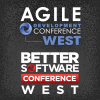Agile Development Conference & Better Software Conference West 2010

PRESENTATIONS
|
Five Core Metrics to Guide Software Project Endgames
By its very nature, the endgame of software projects is a hostile environment. Typical dynamics include tremendous release pressure, continual bug and requirement discovery, exhausted development teams, frenzied project managers, and “crunch mode” for testers. However, hope and relief are available. By using metrics derived from defect discovery and repair patterns, you can learn how to guide projects toward a successful release with less stress and more certainty. |

Bob Galen, iContact |
|
From Big Boss to Servant Leader
It's fashionable these days to decry the command and control style of management. Although self-organizing teams are all the rage, managers are still responsible for ensuring that teams perform the work that needs to be done and deliver value to the organization. If you are or have been the big boss, you don't just wake up one morning as a different person. Esther Derby shares the servant leader way to think about management that moves from mandate and monitor to guide and support. |

Esther Derby, Esther Derby Associates, Inc. |
|
Harmful Project and Management Patterns Revealed
Every organization has its own project patterns. Some management teams take a long time to start a project. Others interrupt and divert the project teams once they've started. |

Johanna Rothman, Rothman Consulting Group, Inc. |
|
Involve Your Customers for Better Requirements
Have you ever heard something like “This feature (system) doesn't look anything like what I expected and doesn't do what I want”-even though you were confident that you knew what your customers wanted? Jennifer Bonine presents a strategy for involving customers up front and throughout the requirements definition process. She discusses how you can engage customers and set their expectations for involvement in the project before it begins. |

Jennifer Bonine, Oracle |
|
Is It Good Enough To Ship? Predicting Software Quality
Software quality often gets lots of lip service and little else-until its absence triggers a disaster and stuff hits the wall. Don Beckett shares work he did to determine when the software for a satellite destined to orbit the earth was sufficiently stable to risk being launched. Failure would have cost hundreds of millions of dollars. Don shows how he modeled this problem to answer the “launch/don't launch” question. |
|
|
It's the People; It's Always the People
Why do we insist on calling people "resources"? If software projects were a factory, people would be fungible-interchangeable equipment just like desks and computers. Because software development is highly creative work and not a manufacturing factory, we need to manage people as human beings, not as tasks or resources. Johanna Rothman describes how to find and develop the right people for your teams and projects-people who fit your culture, share your values, and will become integral parts of your team. |

Johanna Rothman, Rothman Consulting Group, Inc. |
|
It's the People; It's Always the People
Why do we insist on calling people “resources?” If software projects were a factory, people would be fungible-interchangeable equipment just like desks and computers. Because software development is highly creative work and not a manufacturing factory, we need to manage people as human beings, not as tasks or resources. Johanna Rothman describes how to find and develop the right people for your teams and projects-people who fit your culture, share your values, and will become integral parts of your team. |

Johanna Rothman, Rothman Consulting Group, Inc. |
|
Making Agile Work in Highly Regulated Environments
Highly regulated industries-avionics suppliers, medical device companies, and pharmaceutical manufacturers-must meet rigorous quality standards to ensure their products are not a danger to the general public. Although compliance has traditionally been achieved with heavyweight waterfall or V-model development methodologies, you can implement agile-or lean-agile-development practices that adhere to standards-based regulations while reducing the risk and improving software quality and reliability. |
|
|
Managing and Eliminating Technical Debt
Many organizations look at technical debt as an inevitable byproduct of developing and delivering software. They struggle with managing their existing debt as well as searching for ways to make it go away. Instead, learn how to manage and eliminate your current technical debt while avoiding additional debt in the process. Lee Henson shows how-no matter what your organizational role-to make sensible business decisions for development and avoid technical debt at the same time. |
|
|
Mastering Dependencies in Your Product Backlog
Agile teams may unintentionally assume significant risk and excessive rework by not addressing dependencies in the product backlog. While the business defines the minimum requirements needed to deliver value and when to deliver that value-delivery dependencies-the agile team determines the necessary sequence of development-development dependencies. The challenge for everyone is balancing delivery and development dependencies. |

Ellen Gottesdiener, EBG Consulting |


